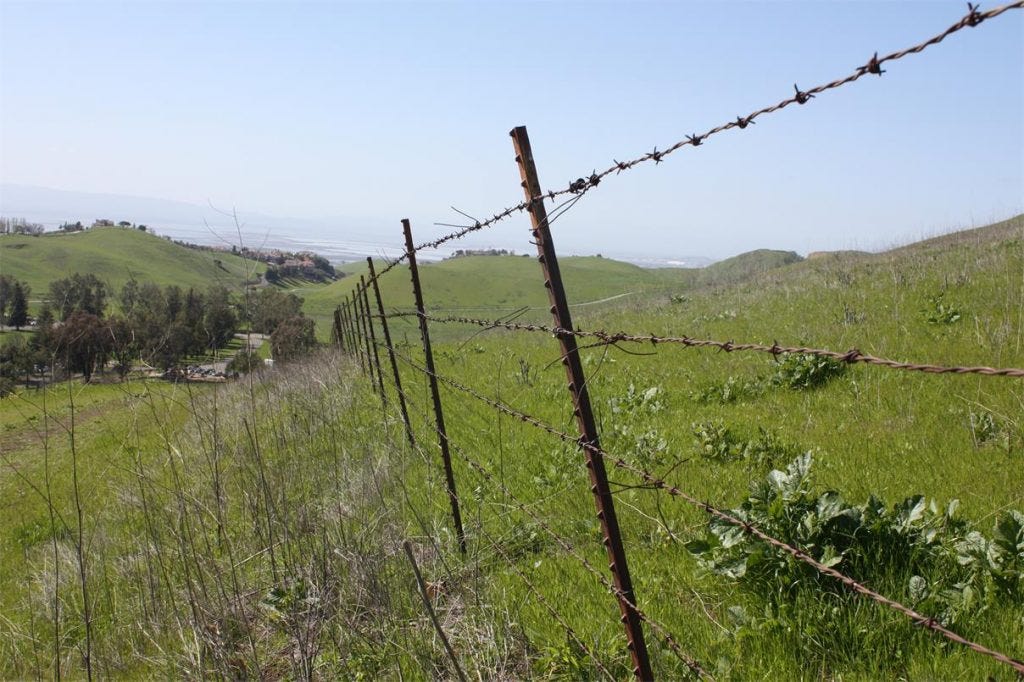Fences
We've put up a lot of fences, and sometimes they get in the way of critters
The subject of fences was chosen in collaboration with Melanie Newfield, a botanist from Wellington, New Zealand, who writes about conservation, science, climate change, and related topics at The Turnstone on Substack. We will be hearing from Melanie later this month about how fences are being used as conservation tools in New Zealand.
Previous Dispatches have concentrated on the barriers we’ve placed in the way of other living creatures: the dams that keep fish from reaching upstream or downstream, and the freeways that block the movement of large mammals. It may be easy to overlook the similar effects that fences have on wildlife. After all, these effects seem far less imposing. As a kid, I remember watching deer jump over the barbed wire fences that kept our cows on our farm. I thought nature was doing just fine as far as our fences were concerned.
But fences are among the oldest and most pervasive barriers we’ve built. All the fencing in the world might exceed the total length of roads by an order of magnitude, and that number continues to grow.
Rabbits and snakes might have no behavioral changes once a barbed wire fence goes up, but larger mammals sometimes do. If they don’t immediately jump over the fence or otherwise find a way under it or through it, they will do what people might to do in the same situation. Some larger animals “patrol” the fence, looking for openings, while others deflect away, retreating in the direction from which they came. They might go back and forth along a short segment of the fence, or even get trapped for a time when they wander into a more enclosed area of fencing.

A team of scientists recently examined the effects of fencing on two large North American mammals, the pronghorn antelope and mule deer, both of which can range over large areas. For the research site, the scientists chose a 6,700 square mile portion of Wyoming that ranges from sagebrush, to aspen woodland, to pine forests. The habitats are used by both pronghorn and mule deer for seasonal migration. Most of the fencing is in the southern part of the study area and made up of four or five-strand barbed wire that is used for livestock and right of ways along roads.
Not only is Wyoming the natural habitat for pronghorn and mule deer, it also has a lot of fences. One Wyoming county alone has more than 4,500 miles of fencing, about a thousand miles more than driving from Bangor, Maine, to San Diego, California.
Pronghorns occupy deserts, grasslands, coastal sage, and chaparral from Canada, though the Western United States, south into Mexico, feeding mostly on sages, forbs, and grasses. They may range up to 100 miles from winter ranges to avoid deep snow. Mule deer range over more varied landscapes, from forests, to chaparral, to grasslands throughout North America, and eat mostly succulents. They tend to confine themselves to home ranges, but like pronghorns, they migrate from higher elevations to lower with the onset of winter.
The scientists found that for both pronghorns and deer, almost 40 percent of their fence encounters altered their normal movement. Most often, both species “bounced” from the fencing, meaning that they retreated from the fence. Otherwise the pronghorns and deer would scout back and forth along the fence, or patrol, looking for an opening. On a few occasions the animals got trapped in partially enclosed fenced areas. The scientists published their findings in the Journal of Applied Ecology in January of this year.
Just put yourself into the hooves of these animals. The bouncing, or looking for an opening are like getting stuck in traffic or hitting some kind of roadblock, which is a big wast of time. Gazelles in Mongolia have traced fences for as long as 59 days before finding a crossing. Animals also injure themselves as the try to cross fences. Mule deer can get their legs tangled in barbed wire and die, the same can happen to pronghorns getting their antlers stuck as they try to make their way under a fence.
Such restrictions on the movement of large animals has been found by other recent research to cause population declines in species. There has been a push to transition to semipermeable fencing, which is intended to rein in cattle but allow passage for other large animals such as elk, but even these more ecologically friendly constructions have been found to restrict large animal movement and compromise their ability to find food or breeding sites.
Because they can be problematic, some folks have started removing fences altogether from our landscapes. As this problem has just recently received attention from policy makers and scientists, the movement is still small. Still, there are such organizations as the Absaroka Fence Initiative that works with landowners to convert to more environmentally friendly fencing or remove fencing altogether.
For more environmental news follow me on Twitter @EcoScripsit.



I've built untold miles of fence on farms and as right-of-way markers on Interstate highways. Most of the fence was low enough for deer to easily jump over. However, this article reminded me of one spot in southern WV where a deer wandered into the construction storage area. He looked around until something spooked him and then he began trying to get out. I don't know how many times he jumped into and bounced off the fence, it was almost as if he couldn't see the wire, but he eventually found the gate and ran away down the dirt road leading up to the storage space for fencing supplies and huge machinery used to build the Interstate highways.
Richard Godfrey